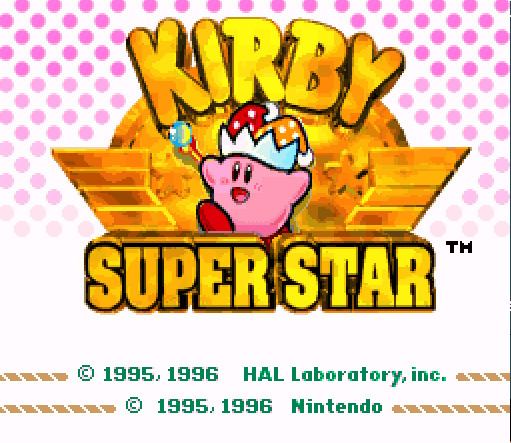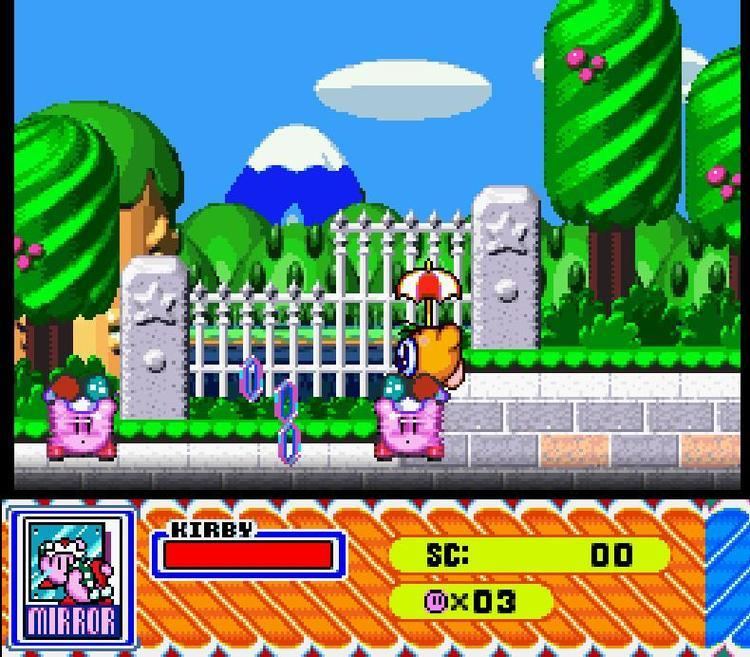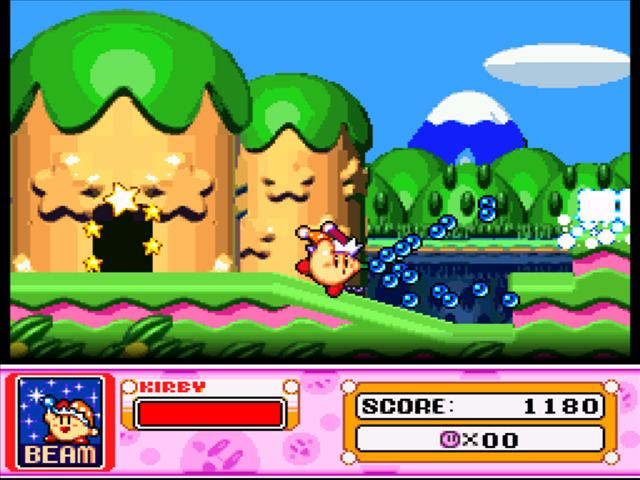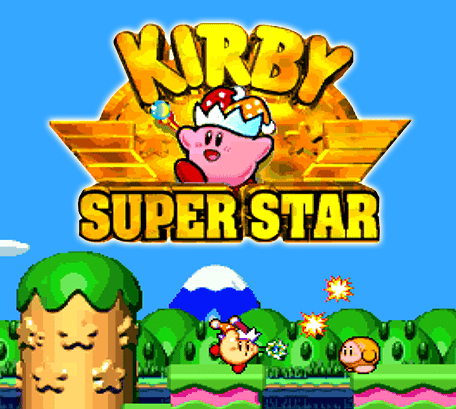9 /10 1 Votes
4.6/5 Emuparadise | 9/10 Games Lol Initial release date 31 July 1995 | |||||||||||||||||||||||||||||||||
 | ||||||||||||||||||||||||||||||||||
Producer(s) Satoru IwataShigeru Miyamoto Composer(s) Jun IshikawaDan Miyakawa Similar | ||||||||||||||||||||||||||||||||||
Kirby super star video walkthrough
Kirby Super Star, known as Kirby's Fun Pak in Europe and Hoshi no Kirby Super Deluxe (星のカービィスーパーデラックス, Hoshi no Kābī Sūpā Derakkusu, lit. "Kirby of the Stars Super Deluxe") in Japan, is a 1996 platforming video game developed by HAL Laboratory and published by Nintendo for the Super Nintendo Entertainment System video game console. It was first released in Japan on March 21, 1996, in North America on September 20, 1996, and in Europe on January 23, 1997. Kirby Super Star's box art states that the game features eight games in one cartridge. Most of these games are platforming-oriented, while some are mini-games. The game was later released for the Wii Virtual Console in Japan in October 2009 and in North America and Europe in May 2010 while the Wii U Virtual Console version was released in Japan on May 1, 2013 and in North America and Europe on May 23, 2013, although the Wii U Europe users get the North American version instead. An enhanced remake titled Kirby Super Star Ultra was released for the Nintendo DS in 2008.
Contents
- Kirby super star video walkthrough
- Best of game grumps kirby super star
- Gameplay
- Spring Breeze
- Dyna Blade
- Gourmet Race
- The Great Cave Offensive
- Revenge of Meta Knight
- Milky Way Wishes
- The Arena
- Sub games
- Remake
- DS exclusive modes
- Reception
- Legacy
- References

Best of game grumps kirby super star
Gameplay

Kirby Super Star sees players take on the role of Kirby, who can float around the screen, inhale blocks and enemies and spit them out. By swallowing certain enemies after inhaling them, Kirby can copy their abilities and use them as his own, becoming able to perform a wide range of attacks. A unique feature of the game is the addition of helpers. When Kirby is in possession of an ability, he can choose to transform it into a helper character which can be controlled by a second player or the computer AI (certain abilities such as Crash or Mike cannot be turned into helpers). Kirby can choose to give the helper a different form, or revert them into a power up to use on himself in an emergency. Certain helpers, such as Wheelie, allow Kirby to interact with them during two player play. If the helper takes too much damage, there is a short time for Kirby to grant it a new power before it disappears until Kirby creates a new one. However, if Kirby takes too much damage, he will lose a life.
Gameplay takes place across seven main modes and several sub-games:
Spring Breeze

Spring Breeze is a simplified remake of the original Kirby's Dream Land, albeit with the gameplay enhancements of Super Star. Kirby must make his way to a castle to challenge King Dedede, who has stolen food from the citizens of Dream Land. Unlike the original, Float Islands and Castle Lololo have merged and Kabula does not appear. Also, upon reaching Castle Dedede, Kirby does not have to face all the previous bosses he fought.
Dyna Blade

Dyna Blade is an original mode in which Kirby must stop Dyna Blade, a giant bird who is disturbing Dream Land's crops. The mode comprises four levels that the player must clear before facing off against Dyna Blade. There are also two secret areas and a mini-boss that moves across the world map.
Gourmet Race

Gourmet Race is a race type mode in which Kirby must race against King Dedede whilst eating as much food as possible. Taking place across three levels of varying length, the winner is whoever earns the most points by the end of all three levels, with bonus points awarded for being the first to finish each race. Players can choose to race either King Dedede or his "ghost", which is the player's best attempt at the race, or simply race alone for the fastest time. The DS version features multiplayer functionality.
The Great Cave Offensive
The Great Cave Offensive is a Metroidvania adventure type mode which sees Kirby exploring a cave searching for treasure. Hidden throughout the game's four areas are sixty treasure chests, with a maximum score of 9999990 achievable by collecting all 60 treasures. Some of the treasures are references to other Nintendo games, such as the Triforce, the Screw Attack, Captain Falcon's Helmet and a Mr. Saturn. Other treasures reference valuable items that appear in RPGs such as Orichalcum.
Revenge of Meta Knight
Revenge of Meta Knight sees Kirby attempt to destroy Meta Knight's battleship, the Halberd, before Meta Knight can conquer Dream Land. Each area has a time limit, which will cost Kirby a life if it hits zero. It is particularly plot-based, featuring comments from the various crew members of the Halberd. Every time you beat a round, at first Kirby tries to get back on the Halberd, but when he gets on, the ship takes damage after every round beaten. At the bottom of the screen, there is a meter showing how the Halberd is doing. Bosses appear such as Twin Woods, two Whispy Woods, and Heavy Lobster, a robotic lobster-like machine. This culminates in fighting Meta Knight twice, in a duel, and in a chase to escape the falling Halberd.
Milky Way Wishes
Milky Way Wishes is the largest game in the collection. As the Sun and Moon around planet Popstar are fighting, a creature named Marx tells Kirby he must travel across nine different planets and restore the giant comet-clock NOVA, who can grant any given wish. Unlike the other modes, Kirby cannot copy the abilities of enemies he inhales; instead, he collects "Copy Essence Deluxes". These are items with abilities on them that, once in Kirby's possession, it allows the player to select them from a list of abilities and they are permanently kept throughout the entire game. The mode also features scrolling shooting sections near the end. In the end, Marx wishes to NOVA his "dream", to control Popstar. Kirby stops this by destroying NOVA's heart, then battling Marx in his powerful form and defeats him.
The Arena
The Arena is an endurance mode that challenges the player to fight every boss in the game, as well as a Waddle Dee with high endurance, one after the other without dying once. The total boss battles include 26 bosses in 19 rounds. In between rounds is a room with five Maximum Tomatoes, which can only be used once each, and two randomly selected pedestals which will grant the player certain powers (the player can choose any power at the beginning of the game).
Sub games
Both of these modes are playable either against the computer or with two players.
Remake
A remake of the game, titled Kirby Super Star Ultra, known in Japan as Hoshi no Kirby Ultra Super Deluxe (星のカービィ ウルトラスーパーデラックス, Hoshi no Kābī Urutora Sūpā Derakkusu, lit. "Kirby of the Stars Ultra Super Deluxe"), and in Korea as Byeolyi Kirby Ultra Super Deluxe, was released for the Nintendo DS in 2008. It includes all games found in the original, but adds several new ones, as well as featuring enhanced graphics, music, and sound effects and including 3D FMV cutscenes for all of the levels. Some translations are different; for example, what was translated as "Sir Meta-Knight" in the Super NES version is now translated as "Lord Meta Knight" in the DS version, and some Great Cave Offensive treasures' names have been re-translated to reference other Nintendo series as they did in the Japanese version (e.g. "Turtle Shell" is now "Koopa Shell", "Screw Ball" is now "Screw Attack", and "Sword" is now "Falchion").
DS exclusive modes
The following modes are exclusive to the Nintendo DS remake, Kirby Super Star Ultra.
Reception
Kirby Super Star was both a critical and commercial success, selling over one million copies in Japan. It received "favorable" reviews according to the review aggregation website GameRankings, and is widely regarded as one of the best games of the franchise. Nintendo Life praised the "impressive" musical score and "colorful" visuals.
Kirby Super Star Ultra received "generally favorable reviews" according the review aggregation website Metacritic. In Japan, Famitsu gave it a score of 32 out of 40. 1UP praised the game for its multiplayer and describes it as "excellent", but noted that it was not very difficult and the level design was not as intricate as in the Mario series. IGN's Craig Harris said that, while fun, the game is "a bit on the easy side".
On December 11, 2008, Super Star Ultra became a Famitsu Gold title. As of January 11, 2009, Kirby Super Star Ultra has sold 1,021,000 copies in Japan. It was also the ninth best-selling game of Japan in 2008. As of December 2008, it was the fifth best-selling Nintendo DS game in the U.S.
Legacy
Many of the music tracks in Kirby Super Star have been remixed in various games, such as the Super Smash Bros. series.
Kirby Super Star was made available on the Wii Virtual Console in Japan on October 13, 2009, in North America on May 17, 2010 and in the PAL region on May 28, 2010. The Wii U Virtual Console version was later confirmed and was released in Japan on May 1, 2013 and was released in North America and Europe on May 23, 2013. When released in Europe for the Wii U Virtual Console, the North America version was included instead of the Europe version. It was also one of the games included in Kirby's Dream Collection, which was released for the Wii in celebration of the series' 20th anniversary.
Meta Knight's battleship, the Halberd, would reappear in Kirby: Squeak Squad, Super Smash Bros. Brawl, Kirby's Epic Yarn, Super Smash Bros. for Wii U, and Kirby: Planet Robobot.
A stage based on The Great Cave Offensive appears in the Wii U version of Super Smash Bros. for Nintendo 3DS and Wii U. In reference to the scope of the mode of the same name, the arena is amongst the largest stages in the game's catalog, and thus supports up to eight players. It features a unique mechanic dubbed the "Danger Zones", stage hazards that instantly KO any fighter whose percentages exceed 100%.
